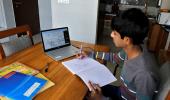One in five students drop out from school.
Abhishek Waghmare reports.

Opposite the gates of Savitribai Phule Pune University, one of the premier universities in India, thousands of students attend graduation courses at the Modern College of Commerce.
Every academic session, the number of students signing up exceeds the previous year. But so does the fee. But there is another constant, reminds Namdev Doke, who mans the institute's examination centre.
"Around 30 per cent of students drop out by the third year, when we begin compiling their final grades and graduation certificates," says Doke.
"If this is the situation in Pune, a city known for its education legacy, I shudder to think of the state in nondescript towns," he rues.
Three hundred and fifty miles from Pune, in the cotton-rich Yavatmal district, Akshay Vyawahare has decided to drop out without completing his certificate course in accounting, for two compelling reasons: One, he wants to devote more time to driving a cab to fund the medical expenses of his ailing father, and two, he wants to save up for college, private tuition, reading material, and fuel.
Vyawahare's shoes are not too big to fill. Many like him are following in his footsteps.
In 2017-2018, the proportion of diploma and certificate-level students who officially dropped out of college stood at a staggering 12.7 per cent, up from 4.4 per cent in 2014.
Around 20 per cent dropped out of school in the ninth and tenth grade in 2017-2018, reveals a report from the National Statistical Office.
This is a clear deterioration in access to higher education in India in the 2014-2018 period, even as Minister for Human Resource Development Ramesh 'Nishank' Pokhriyal unveiled his government's new education policy.
The policy intends to raise education spending in the country to 6 per cent of GDP. India currently spends 3.8 per cent of GDP on education, against the global average of 4.5 per cent, says the World Bank.
The report also finds that the dropout rate has hovered around 5 per cent for graduates, with no improvement from 2014 to 2018.
This is grimmer than the higher rates at lower educational levels, as the enrolment at the graduate level is as low as 26 per cent in India, against nearly 100 per cent at the primary level.
Consider the 5 to 29 age group as base. It shows the share of persons 'currently attending' school/college has declined.
At the same time, the share of persons who had once enrolled but currently not attending school/college has risen.
Pranati Panda, who heads the government-funded National Institute of Educational Planning and Administration, says fewer youngsters are opting for higher education.
"The transition from the secondary and higher secondary levels to higher levels of education seems to be declining, and the reasons are manifold," she says.
Some improvement though is noticeable.
For example, the attendance ratio has improved. A larger share of students in a particular age group attends the class it should. But the cheer quickly dissipates.
Around 40 per cent of students who should be in secondary school (Classes 8, 9, and 10) are still conspicuously absent.
The NSO report finds that about 12 per cent of girls drop out to get married, another 32 per cent for 'domestic activity'. For boys, more than a third drops out to earn.
Teachers and experts say this data reflects the on-ground situation.
"For boys, the reasons to drop out are mostly financial. Most girls get married in the first or second year of their degree course," says Siddhesh Sarma, who co-founded Leadership for Equity, an education advocacy in Pune. Sarma works with the state government of Maharashtra on improving the education policy.
"You will be shocked to see the proportion of girls discontinuing college studies to get married," says Sarma.
Nonetheless, financial limitation is the prime mover for school dropout rate being alarmingly high.
While more than 70 per cent students receive free primary education, only one in four receives that at the secondary level.
At the graduate level, nine out of 10 students end up paying for education. One reason could be that more than half the students get educated in costlier private institutes -- more so after Class 12.
Sarma says the spending on higher education is high compared to the low per capita income in India. "This is a huge deterrent," he says.
Experts across the country have advocated for enhanced government spending on education to impBVrove schools and bring prospective students on board.
Gajanan Virkar, who teaches science at Shivaji College in Akot, some 200 miles from Nagpur, says parents who prefer to get their children enrolled in English medium schools backtrack to pay the fee required for higher education.
"Paucity of funds means schools lack infrastructure, and teacher vacancies do not get filled fast. Further, students as well as teachers want to stay on in cities, and no one cares about the state of educational institutions in the hinterlands," adds Virkar.
But times have changed. COVID-19 has imposed a steep learning curve. The pandemic has upended learning and forced a rethink on education in the new normal.
Doke polled 500 students to gauge their readiness to go online this year, only to find that half of them cannot afford more than 1 gigabyte of data every day.
"How can students attend classes if they do not have access to enough data?" asks Doke.
COVID-19 has worsened the situation across sectors, but the impact on education has been too deep, yet widely unreported, he thinks.
Feature Presentation: Mahipal Soni/Rediff.com











